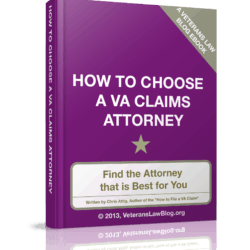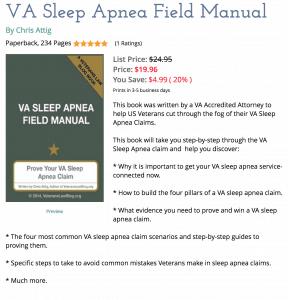The Federal Circuit has invalidated certain parts of three supplemental claim regulations under the Appeals Modernization Act, or AMA: 38 C.F.R. §14.636(c)(1)(i), 38 C.F.R. §3.2500(b), and 38 C.F.R. §3.155.
In doing so, the Federal Circuit explained how these three supplemental claim regulations cut against the very purpose and goals of the AMA appeals process Congress wanted implemented.
You can read the Federal Circuit’s full 63-page opinion by clicking here.
The case is the consolidated appeals of several organizations (Military-Veterans Advocacy, NOVA, Paralyzed Veterans of America, Carpenter Chartered, & Haisley) challenged the VA’s 2019 AMA regulations under 38 U.S.C. §502 (Docket Nos. 2019-1600, 2019-1860, 2019-1685, 2019-1687).
This post will be a quick summary of the invalidated regulations and generally what it means for your VA claims and appeals under the AMA. We will be discussing this case for a long time, though.
A Quick Overview of the AMA appeals process.
Frustrated by an ever-growing backlog of VA claims and appeals, around 2013 to 2014, the Obama Administration began pushing for reform to the then-existing appeals process, what we now call the Legacy appeals process. You can refresh your memory on how the Legacy appeals process worked by clicking here.
It took years of negotiations with the VA, Veterans Service Organizations (VSOs), veterans advocacy organizations like the National Organization of Veterans Advocates (NOVA) and the National Veterans Legal Services Project (NVLSP), but what ultimately emerged is an appeals process that offers several options to challenge a bad VA Rating Decision.
We call that new appeals process the Appeals Modernization Act, or “AMA” for short.
The foundation of the AMA process is the “claim,” of which there are many types: original, initial, supplemental, and (sort of) CUE claims.
After a veteran files an initial claim (the first claim to raise a particular issue) she can seek review of a bad VA rating decision at the “AOJ” level by filing either a supplemental claim or a Higher Level Review. The Supplemental claim is the centerpiece of the AMA process; where a veteran under the Legacy system could file a claim to reopen by providing new and material evidence, under the AMA, a veteran can file a supplemental claim with new and relevant evidence.
Alternatively, she can appeal the VA’s denial of her claim to the Board of Veterans Appeals (BVA). There are three ways to appeal: a direct review appeal What did the Court say about the BVA direct review lane under AMA?(no new evidence or hearing), an appeal that allows evidence submission on a specific timeline, or an appeal that allows the veteran to have a hearing, with evidence submission, before a BVA judge.
What is a VA Regulation?
Once the AMA was passed into law by Congress and signed by the President, the VA began to prepare regulations to implement the new system. Those regulations are supposed to fill gaps in the statutory process left by Congress, or to lay out more specific processes and rules to carry out Congress’s intent.
You can tell the difference between the statute and the regulation by how lawyers and judges cite to them.
Citations to 38 U.S.C. are citations to statutes, specifically, Title 38 of the United States Code.
Citations to 38 C.F.R. are citations to VA regulations, specifically, Title 38 of the Code of Federal Regulations.
When a veteran, or an affected organization, feels that a VA regulation is unlawful, or somehow improper, they can challenge the new regulations to the US Court of Appeals for the Federal Circuit under the process laid out in 38 U.S.C. §502. This type of challenge is unique – because it challenges the validity of the regulation as it applies to all people affected by it. It is different from a challenge to the interpretation of a VA regulation in a particular veteran’s claim or appeal.
The case we are talking about today addressed who has legal “standing” to bring these sorts of “reg challenges.” Read the decision by clicking here.
In any event, the case we are looking at today is the result of a rule challenge under §502.
A veteran, and multiple veterans and advocacy organizations, filed “rule challenge petitions” with the Federal Circuit. Those organizations include Military-Veterans Advocacy, the National Organization of Veterans Advocates (NOVA), Paralyzed Veterans of America (PVA), the National Veterans Legal Services Project (NVLSP) and Carpenter Chartered.
In the interest of full disclosure, I have served on the Board of Directors of NOVA https://www.vetadvocates.org/cpages/board-and-staffsince 2015. And as the co-chair of NOVA’s Amicus and Litigation committee, I was one of a handful of folks from NOVA who worked with the lawyers representing NOVA in the rule challenge.
While the consolidated lawsuits of the MVA, PVA, NOVA, NVLSP, Carpenter Chartered and the individual veteran challenged a number of AMA regulations, the Federal Circuit’s decision focused on three supplemental claim regulations that it found cut against the letter and spirit of the AMA.
We will look briefly at each of the three supplemental claim regulations that the Circuit invalidated.
1) Veterans and survivors can file an “intent to file” in conjunction with a supplemental claim.
Years before the AMA, the VA phased out “informal claims” – I am not going to go into this area of the law too much, as “informal claims” are incredibly complex.
The VA replaced this legal construct with the “intent to file” – a form that, under AMA, a veteran can file and, under AMA, will protect the date of the “intent to file” as the claim’s effective date. The thinking was that veterans could file an intent to file, and spend up to a year preparing their claims without losing an early effective date.
Under AMA, the VA interpreted one of the more important supplemental claim regulations – 38 C.F.R. §3.155 – is such a way that veterans could only file “intent to file” forms for original or initial claims.
The Federal Circuit found the VA’s attempt to exclude “supplemental claims from the intent-to-file framework is arbitrary and capricious,” particularly in light of the fact that the Secretary appeared to offer no defense of its regulation and no reasoning that supported the regulation.
2) Veterans and Survivors can file a Supplemental Claim WHILE appealing to the Veterans Court or Federal Circuit.
The second of the supplemental claim regulations invalidated by the Federal Circuit was 38 C.F.R. §3.2500(b), but only to the extent that it prohibited the filing of a supplemental claim when adjudication of the same claim is pending before a federal court.
The language of this supplemental claim regulation that was invalidated is in red, below. The rest of the regulation is still valid and good law.
(b) Concurrent election prohibited. With regard to the adjudication of a claim or an issue as defined in § 3.151(c), a claimant who has filed for review under one of the options available under paragraph (a) of this section may not, while that review is pending final adjudication, file for review under a different available option. While the adjudication of a specific benefit is pending on appeal before a federal court, a claimant may not file for administrative review of the claim under any of options listed in paragraph (a) of this section.” 38 C.F.R. §3.2500(b)
The Federal Circuit found that Congress left no gap, or ambiguity, in 38 U.S.C. §5104C, which barred only concurrent administrative review and not concurrent judicial and administrative review.
The VA’s attempt to use judicial review to create another hurdle to overcome when filing a supplemental claim contradicted Congressional intent to extend “broad availability of supplemental claims” to improve VA efficiency. And the VA’s regulation hindered veterans’ ability to get the earliest effective date possible by continuously pursuing their AMA claims and appeals.
Bottom line – if you appeal a bad BVA decision to the Court of Appeals for Veterans Claims (aka, the CAVC), you can still file a Supplemental Claim within one year of that decision (so long as the VA Rating decision being appealed was issued on/after February 19, 2019).
This is a significant decision which I think will continue to be referred to by both Courts – and I believe it is the cornerstone that will help to reshape the roles of the VA, the BVA, and both courts in adjudicating veterans claims and appeals.
3) Attorneys may charge fees on supplemental claims.
The third of the supplemental claim regulations invalidated by the Circuit Court was 38 C.F.R. §14.636(c)(1)(i), but only to the extent that it limited when a veteran’s accredited representative may charge fees for work on supplemental claims.
Here’s the language from the regulation, with the portion in red being the portion that the Circuit Court invalidated. The remainder of the regulation remains intact.
“(i) Agents and attorneys may charge claimants or appellants for representation provided after an agency of original jurisdiction has issued notice of an initial decision on the claim or claims if the notice of the initial decision was issued on or after the effective date of the modernized review system as provided in § 19.2(a) of this chapter, and the agent or attorney has complied with the power of attorney requirements in § 14.631 and the fee agreement requirements in paragraph (g) of this section. For purposes of this paragraph (c)(1)(i), an initial decision on a claim would include an initial decision on an initial claim for an increase in rate of benefit, an initial decision on a request to revise a prior decision based on clear and unmistakable error (unless fees are permitted at an earlier point pursuant to paragraph (c)(1)(ii) or paragraph (c)(2)(ii) of this section), and an initial decision on a supplemental claim that was presented after the final adjudication of an earlier claim. However, a supplemental claim will be considered part of the earlier claim if the claimant has continuously pursued the earlier claim by filing any of the following, either alone or in succession: A request for higher-level review, on or before one year after the date on which the agency of original jurisdiction issued a decision; a supplemental claim, on or before one year after the date on which the agency of original jurisdiction issued a decision; a Notice of Disagreement, on or before one year after the date on which the agency of original jurisdiction issued a decision; a supplemental claim, on or before one year after the date on which the Board of Veterans’ Appeals issued a decision; or a supplemental claim, on or before one year after the date on which the Court of Appeals for Veterans Claims issued a decision.” 38 C.F.R. §14.636(c)(1)(i).
The Court analyzed Congress’s evolving approaches to attorney fees, and found that a VA regulation banning accredited representatives from charging fees for supplemental claims contradicts Congress’s unambiguous intent that paid representation be available to veterans for all forms of administrative review under the AMA, including supplemental claims.
Supplemental claims are different from original claims, the Court found, because they are a form of administrative review. Its decision did not authorize fees for unaccredited representatives, and it did not authorize fees for administrative/original claims.
It is important to understand what the Federal Circuit did NOT change:
- Only accredited agents and attorneys may charge veterans fees for work. Unaccredited claim sharks – they like to call themselves “claims consultants” – may not charge you fees and you are not legally bound to honor an illegal contract.
- Nobody may charge a fee on an initial claim – there has to be at least one VA rating decision on an issue before fees can be charged.
- Attorney and accredited agent fees must still be reasonable.
The only thing that changed is that veterans seeking to file supplemental claims more than one year after a bad VA rating decision are entitled to hire an attorney to help. And because attorneys can get paid for this work, more veterans can get legal representation earlier in the supplemental claim process.
Given that attorneys have the highest win-rates of all types of legal/accredited representatives, this could well be a game-changer for many veterans who were denied benefits more than a year ago but still feel like the VA got it wrong.
So there are the three AMA supplemental claim regulations the Federal Circuit invalidated.
Let me know your questions in the comments, below.






